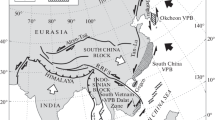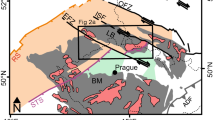Abstract
West of the Main Uralian fault, the main suture in the southern Urals, 40Ar/39Ar apparent ages of amphibole, muscovite and potassium feldspar are interpreted as cooling ages. A fast exhumation of the metamorphic complex of Kurtinsky during Upper Carboniferous time is indicated by the small age difference (15 Ma) between cogenetic amphibole and muscovite. Differentiated movement in the footwall of the Main Uralian fault along strike is indicated by the age difference of 70 Ma between the metamorphic complexes of Kurtinsky (north) and Maksyutov (south). No Upper Paleozoic (Uralian) medium- to high-temperature event is recorded in 40Ar/39Ar data from the metamorphic complex of Beloretzk (MCB). An amphibole age of 718±5 Ma and the occurrence of mafic intrusions might signal the break-up of Rodinia and therefore indicate the rifting period followed by the separate movement of the "Beloretzk terrane". Muscovite ages of approximately 550±5 Ma, the unique pre-Ordovician tectonometamorphic evolution of the MCB and the Late Vendian sedimentary history of the western Bashkirian Megaanticlinorium (BMA) imply the existence of a Neoproterozoic orogeny at the eastern margin of Baltica. This orogeny might have been initiated by the accretion of the "Beloretzk terrane". The metamorphic grade of the overlain Silurian shales and the K/Ar microcline ages from the "Beloretzk terrane" give evidence for a new thermal event at approximately 370 Ma. A microcline age of 530–550 Ma obtained for the Vendian conglomerate in the western BMA suggests that a maximum temperature of approximately 200°C was reached in Cambrian or Vendian times. An orthoclase age (590–630 Ma) of the Vendian Zigan flysch deposits might be inherited from the eastern source area, the Cadomian orogen. An orthoclase age (910–950 Ma) from the Riphean Zilmerdak conglomerate coincides with a documented decrease in the subsidence rate of the Upper Riphean basin.
Similar content being viewed by others
Author information
Authors and Affiliations
Additional information
Received: 11 May 1998 / Accepted: 30 October 1998
Rights and permissions
About this article
Cite this article
Glasmacher, U., Reynolds, P., Alekseyev, A. et al. 40Ar/39Ar Thermochronology west of the Main Uralian fault, southern Urals, Russia. Geol Rundsch 87, 515–525 (1999). https://doi.org/10.1007/s005310050228
Issue Date:
DOI: https://doi.org/10.1007/s005310050228




